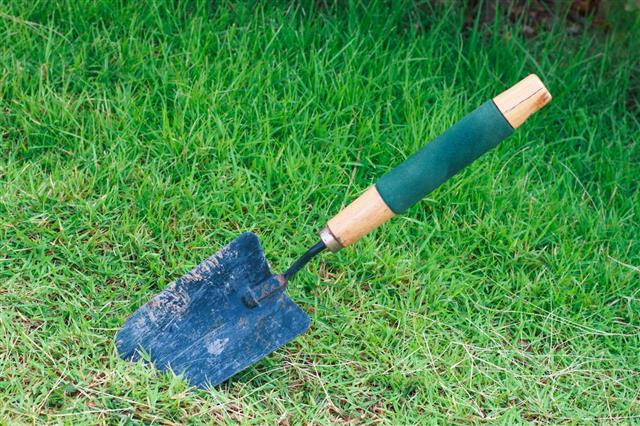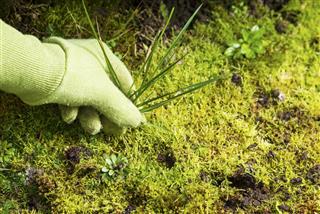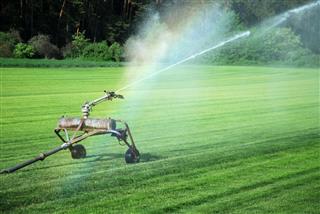
Zoysia grass is a drought-resistant warm-season grass. Dollar Spot, Rust and Brown Patch are some of the most common diseases that could damage the Zoysia grass. In this article, we would find out more about these diseases along with ways to prevent them.
Zoysia is a genus of creeping grasses in the Poaceae family. Native to certain regions of Asia and Australasia, the species under this genus include: Zoysia japonica, Zoysia matrella, Zoysia minima, Zoysia macrantha, Zoysia macrostachya, Zoysia sinica and Zoysia pauciflora. Emerald Zoysia, which is a hybrid between two species called Zoysia japonica and Zoysia tenuifolia, is commonly used on sports turf, golf courses and high-quality lawns. Belaire Zoysiagrass, El Toro Zoysiagrass, Cashmere Zoysiagrass and Meyer Zoysiagrass are other varieties that have been developed. Zoysia grass is a hardy grass that grows extremely well during the summer months. Since it is drought-resistant, watering requirements are lower in comparison to other turf grasses. It is relatively less susceptible to diseases, but one must always watch out for the signs of common diseases. In this article, we would learn about some of the common Zoysia grass diseases along with ways to lower the incidence of such diseases.
Diseases that Affect Zoysia Grass
However hardy Zoysia grass may be, problems can arise if this grass becomes infested with insects. It would also be difficult to maintain this grass if weeds start competing with it for nutrients. Thatch refers to the interwoven layer of dead tissues or partially decomposed plant material like stems, roots and leaf sheaths that lies between the grass and the surface of the soil. If not controlled, thatch may attract disease-causing organisms. Emerald Zoysia, which is one of the popular varieties, is quite susceptible to thatch and winter injury. So, attention must be paid to thatch management as well. It is definitely an essential part of Zoysia grass maintenance. Scroll down to learn about the common diseases and use the following tips on Zoysia grass care to prevent an outbreak of such diseases.
Dollar Spot
Dollar spot is a very common grass disease. The characteristic sign of this disease is the development of small straw-colored spots. These spots appear on the individual leaves and are almost the size of a silver dollar. If the infected leaf blades are checked during the early hours when the grass is still wet with dew, one may also be able to spot white thread-like hyphae of the disease-causing fungus. Sclerotinia homeocarpa is a fungus that is believed to be responsible for causing dollar spot. However, studies have revealed that fungus from Lanzia or Moellerodiscus genus could also cause dollar spot. This disease is likely to develop if the humidity is high and the soil moisture content is low. More often than not, dollar spot develops if adequate amounts of fertilizer are not applied. A timely application of a correct blend of fertilizers will certainly prove beneficial in preventing dollar spot. Dollar spot could also develop if mowing is not done in the right manner. Besides following the right mowing practices, one should also pay attention to thatch management and weed control. The application of a fast release nitrogen fertilizer can help in undoing the damage caused by dollar spot.
Fusarium Patch
Fusarium patch, which is also known as pink snow mold, is a disease that is caused by a fungus called Microdochium nivale. This disease is characterized by the development of yellow spots. It usually occurs when the snow that covers the lawn starts to melt. The yellow spots that are initially 1-3 inches in diameter, then turn brown and form rings that are 12 -24 inches wide. Fusarium patch disease is most likely to damage lawns or turf during autumn and winter. Poor management of thatch can also increase the risk of this fungal disease. Soils that are not well-drained are most likely to develop thick thatch. It is essential that you use an aerifier so as to allow air to penetrate into the compacted soils. You could also use a vertical mower to mechanically remove thatch. Extended periods of drought can also increase the likelihood of infestation, which is why deep watering once every week may prove beneficial. The best time of watering this warm-season grass is during the early hours. Application of a suitable fungicide will also help in controlling the infestation.
Rhizoctonia Blight
Rhizoctonia blight, which is also known as brown patch, is one of the most common diseases that can cause a lot of damage to this grass. Brown patch, as the name suggests, is characterized by the development of light brown circular patches on the affected area. The outer edge of such patches is usually grayish-black in color. The diameter of these patches could lie anywhere between 2 to 3 feet. This fungal disease is most likely to occur when the grass stays wet for a long time. If you do notice signs of this disease, make sure to spray a garden fungicide that contains sulfur. Refrain from watering the lawn in late afternoon especially when it is hot. Make sure that there isn’t excessive buildup of thatch. Once the grass is established, applying 1-2 pounds of nitrogen per thousand square feet annually between May to August should suffice. Excessive application of nitrogen fertilizer, especially during summer may also increase the risk of infestation. So, make sure that you apply nitrogen fertilizer as per the requirements.
Leaf Spot
Leaf spot is another disease that could damage Zoysia grass. It is caused by a fungus called Bipolaris sorokiniana. This fungal disease not only affects the leaves, it could also damage the root and the crown of Zoysia grass. The characteristic sign of this disease is the development of spots that have purplish-black borders. The roots as well as the crowns may also become dark brown to black due to the infestation. Once the leaf blades begin to turn brown, the infected part is most likely to wither and die. The best way to prevent such an infestation is to refrain from using excessive amounts of nitrogen fertilizer. The most suitable time of fertilization is between May to August. Proper mowing and watering practices must also be followed. It would be best to mow your lawn to a height of ½ to 1½ inches. Low mowing promotes the growth of a dense mat. You could also use a mulching mower that can evenly distribute the grass clippings. Do make sure that you mow your lawn when it’s dry.
Pythium Blight
Pythium blight is a fungal disease that is caused by a fungus called Pythium spp. This disease is characterized by the development of circular or irregular water-soaked patches of grass. These patches are usually 6 to 12 inches in diameter. While the grass appears to be greasy in the initial stages, it begins to dry with the progression of the disease. The color of the leaf blades would also change from green to reddish-brown. Soon the areas that are affected by the disease wither and die. If there is a high level of humidity, a gray-colored moldy growth may develop on the damaged areas of the grass. Following a fungicide program is the best way to prevent this fungal disease.
Powdery Mildew
Zoysia spp. is one of the turf grass species that could get infested by powdery mildew. The signs of powdery mildew are most likely to appear in areas that have a dense shade. High relative humidity and excessive use of nitrogen fertilizer could also increase the risk of powdery mildew. If the grass gets infected with powdery mildew, the infected areas develop white-colored powdery patches. If steps are not taken soon, the leaf blades may turn yellow and die after some time. Since this disease is common in heavily shaded areas, it would be a good idea to trim the surrounding trees so as to allow light. Excessive watering must also be avoided. When it comes to watering this grass, one inch of water in a week should suffice. However, frequent watering may be required if leaf blades seem to be wilting due to hot weather. Spraying a garden fungicide that contains sulfur would also help. Using weed control products would also help in preventing growth of unwanted plants in the lawn.
Rust
Rust is another disease that may damage Zoysia grass. More often than not, rust develops when it is warm and humid. This disease usually affects lawn grasses in late summer. Improper mowing may also increase the risk of infestation. The development of reddish-brown spots on the leaf blades and the stem is the characteristic sign of rust. If the grass is infested with rust, one would be able to see reddish-orange dust in the air while mowing the lawn. As the disease progresses, the leaf blades may turn yellow and die. When it comes to prevention of rust, mowing the grass as per the recommended mowing height and applying adequate amounts of fertilizers and fungicides can certainly help.
Besides the aforementioned Zoysia grass diseases, other diseases that could sometimes affect Zoysia grass include slime mold, fairy rings and red thread. Since damage to Zoysia grass is most likely to occur due to infestation by different types of fungi, steps must be taken to prevent the growth of fungi. Insects such as chinch bugs, grubs, crickets, billbugs and sod webworms may also cause damage to the grass. So, be on a lookout for any signs of infestation. Though Zoysia is a drought-tolerant grass that grows best in warmer regions, extended periods of drought could sometimes make it susceptible to diseases. If the lawn is looking bad due to an infestation, you could use pigment-type colorants to dye it green. Since this grass is invasive, it can crossover or overtake the cool season grasses that may be growing alongside. While the cool season grasses would remain green in winter, brown-colored dead spots may develop in areas where Zoysia grass is growing. Moreover, once established, it is extremely difficult to remove. So do consider the climate and the growing conditions before planting this grass.









